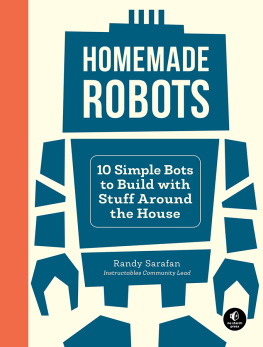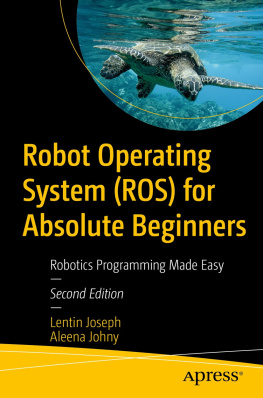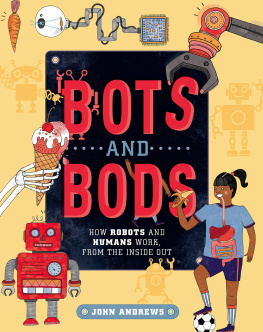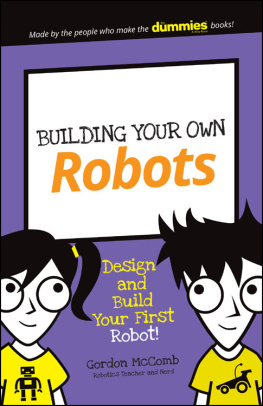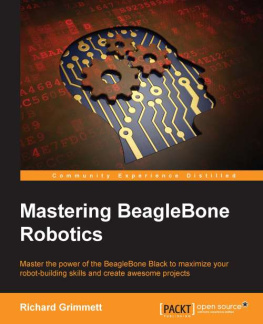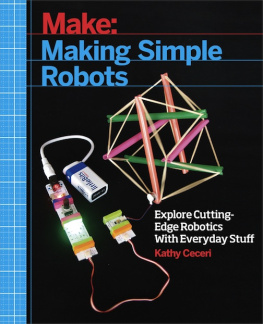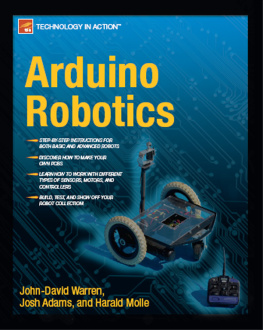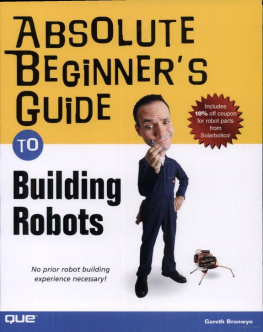Homemade Robots
10 Simple Bots to Build with Stuff Around the House
by Randy Sarafan

San Francisco
Homemade Robots. Copyright 2021 by Randy Sarafan.
All rights reserved. No part of this work may be reproduced or transmitted in any form or by any means, electronic or mechanical, including photocopying, recording, or by any information storage or retrieval system, without the prior written permission of the copyright owner and the publisher.
ISBN-13: 978-1-7185-0023-5 (print)
ISBN-13: 978-1-7185-0024-2 (ebook)
Publisher: William Pollock
Executive Editor: Barbara Yien
Production Manager: Rachel Monaghan
Production Editor: Dapinder Dosanjh
Developmental Editors: Jill Franklin and Patrick DiJusto
Cover Illustrator: Monica Kamsvaag
Interior Design: Maureen Forys, Happenstance Type-O-Rama
Technical Reviewer: Becky Stern
Copyeditor: Bart Reed
Compositor: Maureen Forys, Happenstance Type-O-Rama
Proofreader: Lisa Devoto Farrell
For information on book distributors or translations, please contact No Starch Press, Inc. directly:
No Starch Press, Inc.
245 8th Street, San Francisco, CA 94103
phone: 1-415-863-9900; info@nostarch.com
www.nostarch.com
Library of Congress Cataloging-in-Publication Data
Names: Sarafan, Randy, author.
Title: Homemade robots : 10 simple bots to build with stuff around the house
/ Randy Sarafan.
Description: San Francisco : No Starch Press, 2021. | Includes
bibliographical references and index.
Identifiers: LCCN 2021010148 (print) | LCCN 2021010149 (ebook) | ISBN
9781718500235 (print) | ISBN 9781718500242 (ebook)
Subjects: LCSH: Robots--Design and construction--Amateurs' manuals.
Classification: LCC TJ211.15 .S27 2021 (print) | LCC TJ211.15 (ebook) |
DDC 629.8/92--dc23
LC record available at https://lccn.loc.gov/2021010148
LC ebook record available at https://lccn.loc.gov/2021010149
No Starch Press and the No Starch Press logo are registered trademarks of No Starch Press, Inc. Other product and company names mentioned herein may be the trademarks of their respective owners. Rather than use a trademark symbol with every occurrence of a trademarked name, we are using the names only in an editorial fashion and to the benefit of the trademark owner, with no intention of infringement of the trademark.
The information in this book is distributed on an As Is basis, without warranty. While every precaution has been taken in the preparation of this work, neither the author nor No Starch Press, Inc. shall have any liability to any person or entity with respect to any loss or damage caused or alleged to be caused directly or indirectly by the information contained in it.
This book is dedicated to anyone who ever wanted to build a robot but was too scared to try.
About the Author
Randy Sarafan creates interactive objects that inject fun and whimsy into everyday life. His previous book, 62 Projects to Make with a Dead Computer, makes computer reuse fun and accessible. Randys work has been celebrated in books, newspapers, magazines, tabloids, academic journals, news blogs, and on television, radio, and podcasts. For more than a decade, Randy has worked for Instructables.com where he created hundreds of DIY project tutorials on everything from making pancakes to building giant rideable robots. He received an MFA from San Francisco State University in Digital Media and Emerging Technology and a BFA from Parsons School of Design in Design and Technology. Visit his website at http://randysarafan.com/ to see all of his new and exciting projects.
About the Technical Reviewer
Becky Stern has authored hundreds of DIY tutorials about everything from microcontrollers to knitting. She is currently a product manager at Instructables (Autodesk). Before joining Instructables, Becky worked as a senior video producer for Make: magazine and as director of wearable electronics at Adafruit. She lives in New York City and enjoys riding on two wheels, making YouTube videos, and collecting new hobbies to share with others.
Acknowledgments
I first want to thank Bill Pollock at No Starch Press for taking a chance on this slightly unusual book and letting me stay true to my artistic vision.
Id also like to thank all of the wonderful and hardworking folks at No Starch Press who helped create something of which we can all be proud: Barbara Yien, Dapinder Dosanjh, Jill Franklin, Patrick DiJusto, Bart Reed, Becky Stern, and everyone else who worked to make this book happen.
Another big thank you goes out to Eric Wilhelm. Without his initial support, this book may have never come about.
Id also like to thank my community of peers who never cease to amaze and inspire me.
Finally, I would like to thank my utterly amazing wife, Jenn. Her endless patience and encouragement helped me see this book through to the end.
Introduction
T he idea of building robots can seem daunting, but you dont need to be an engineer, scientist, or wizard to get started. You need only some basic know-how and an open mind. Throughout this book, Ill provide the knowledge you need to begin building robots. In exchange, Im counting on you to be creative, inquisitive, and determined.
Robots come in many different types. Some robots, called humanoids, are smart and humanlike. These are the kinds you typically see in movies and are probably most familiar with. Other robots are more abstract and sculptural. BEAM robots, for example, are small sculptural robots built on the principle of Biology, Electronics, Aesthetics, and Mechanisms. These robots perform simple actions using basic recycled electronic components. Between those two extremes is an entire universe of different types of robotstoo many to name here.
The robots youll be making in this book are closer in spirit to BEAM robots. In fact, I like to call them bots because, like the word bot, these robots themselves are a bit abbreviated, so you can think of the bots described here as bare-bones starting points for future robotic exploration.
All of the bots in this book adhere to the same basic set of rules:
- They are quick and easy to build with readily available materials.
- They are easy to understand and dont require a microcontroller or computer programming.
- They are mobile and autonomous (that is, self-driving).
- They are expandable, allowing you to incorporate more complex electronic controls later.
Are Bots Alive?
No, but they pretend to be. Hold on to your hats as I delve into some theory.
Think about this: fallen leaves blowing in the wind are almost perfectly random, and pistons moving in an engine are almost perfectly mechanical. An object begins taking on living attributes when it has predictable unpredictabilitythat is, not totally random and not totally mechanized. To understand how this works, lets take a detour into the world of video games.
A gaming concept called a core mechanic is a behavior that a player performs over and over again during gameplay. An example of this is continuously pressing the fire button on a controller. Another is making a character jump from platform to platform repeatedly.
With each bot youll build, the core mechanic is the essence of its main behavior. It could be driving forward or backward, spinning in circles, rolling, or jumping. Each bot will have one predictable behavior that seems to come before all the others.

